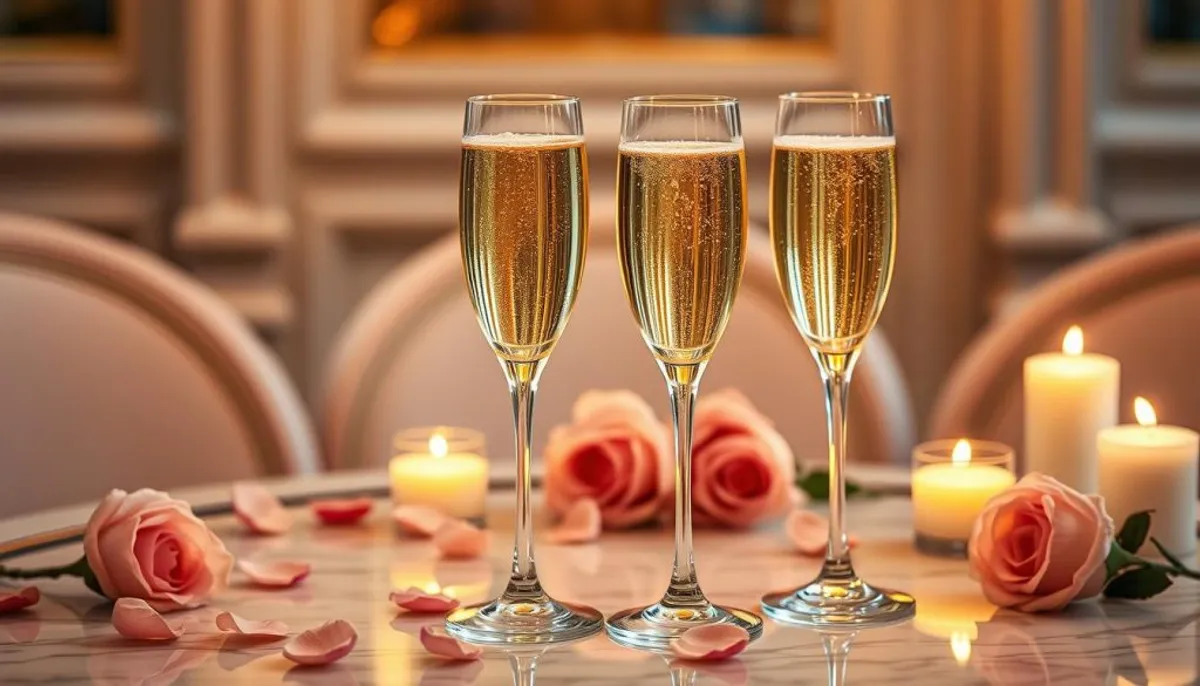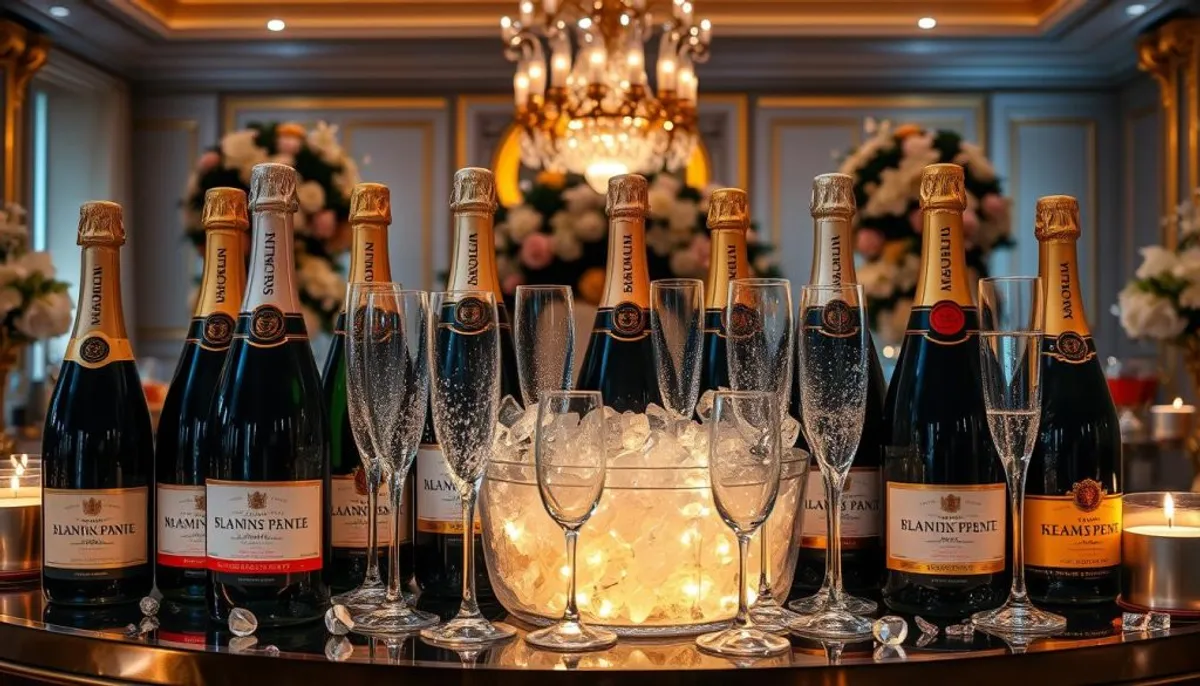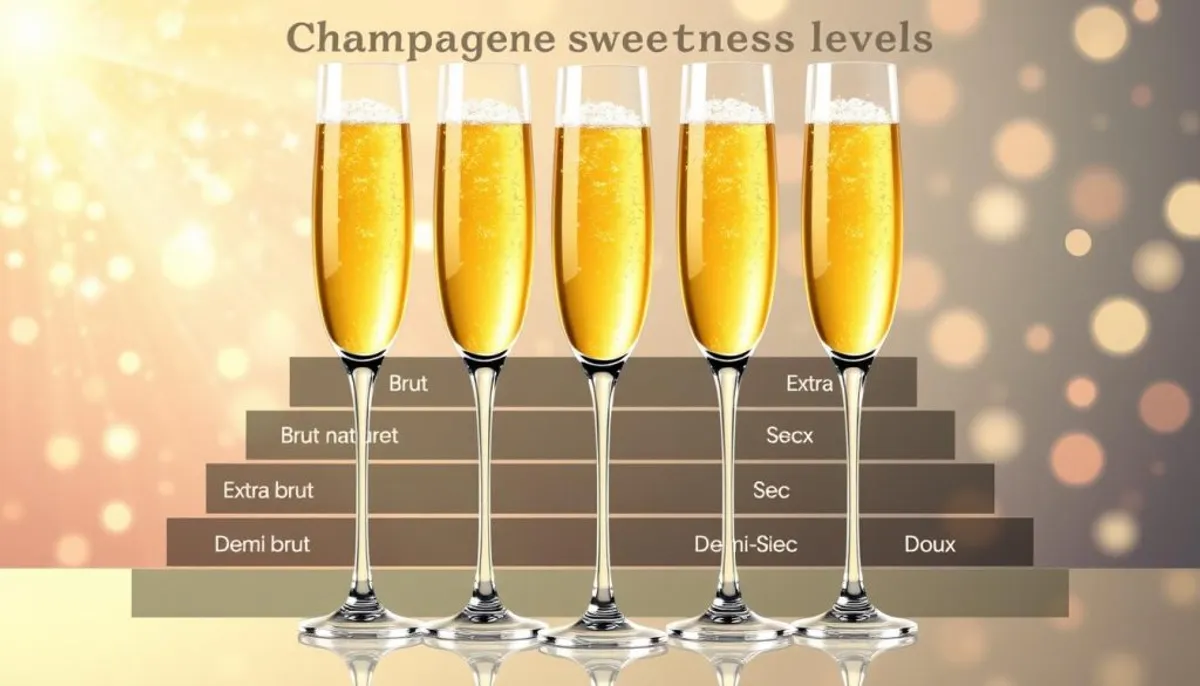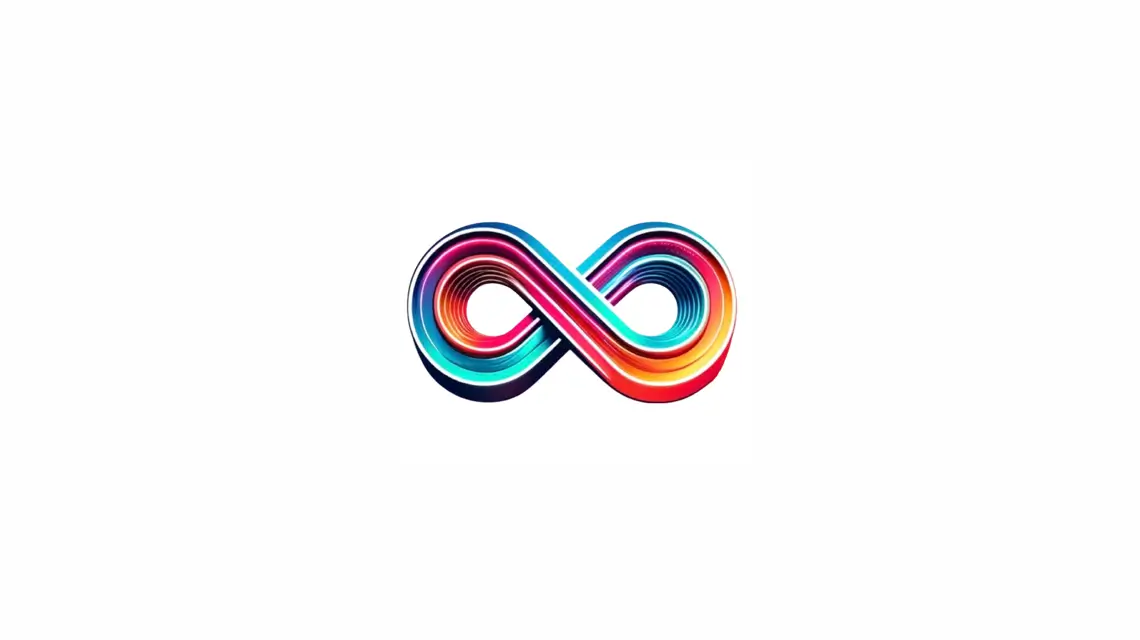Pop the cork and raise your glasses! The world of luxury champagne dazzles anew in 2022, presenting a sparkling array of premium offerings. This year, both prestigious houses and boutique growers have excelled, crafting exquisite bubbles that tantalize the senses.
Champagne, the king of sparkling wines, has long been synonymous with celebration and refinement. With an alcohol content of about 12.2% and a calorie count ranging from 90 to 150 per standard serving, these effervescent elixirs offer a guilt-free indulgence for discerning palates.

The 2022 lineup of top luxury sparkling wines showcases an impressive range. From the crisp Vilmart & Cie Grand Cellier 1er Cru to the bold Krug Rosé 25ème Edition NV, each bottle tells a unique story. These stories reflect the terroir and craftsmanship that make Champagne truly special.
Whether you’re a seasoned connoisseur or a curious newcomer to the world of premium sparkling wines, this guide will help you navigate the finest offerings of 2022. Let’s embark on a journey through the vineyards of Champagne and discover the bottles that are making waves this year.
Key Takeaways
- Champagne remains a symbol of luxury and celebration in 2022
- The best champagne brands offer a wide range of styles and price points
- Premium sparkling wines from Champagne can be excellent long-term investments
- Top selections for 2022 include both vintage and non-vintage offerings
- Champagne prices range from affordable luxury to ultra-premium collectibles
- The UK is the largest consumer of champagne outside of France
- Many top champagnes are available in limited quantities, adding to their exclusivity
Understanding Champagne: The King of Sparkling Wines
Champagne, a symbol of luxury and celebration, has a storied history dating back to the late 17th century. This sparkling wine, exclusively crafted in the Champagne region of France, has enthralled wine aficionados for centuries. Its unique characteristics and production methods set it apart.
What Makes Champagne Different from Other Sparkling Wines
Champagne’s uniqueness stems from its strict production regulations and distinctive terroir. Unlike Prosecco from Italy or Cava from Spain, it is predominantly made from Chardonnay, Pinot Noir, and Pinot Meunier grapes. The region’s unique soil and climate contribute to its exquisite flavor profile.
The Sacred Terroir of Champagne Region
The Champagne region, situated in northeastern France, is home to over 2,000 Champagne houses. Its chalky soil and cool climate create ideal conditions for grape cultivation. The region is categorized into Grand Cru, Premier Cru, and Autre Cru, each producing wines with distinct characteristics.
Traditional Méthode Champenoise
The méthode champenoise, or traditional method, is the hallmark of Champagne production. This intricate process involves a second fermentation in the bottle, creating the signature bubbles and complex flavors. Innovations like degorgement, developed in the late 18th century, were introduced to remove yeast sediments and clarify the wine.
| Champagne Style | Sugar Content (g/L) | Taste Profile |
|---|---|---|
| Brut Nature | 0-3 | Bone dry |
| Extra Brut | 0-6 | Very dry |
| Brut | 0-12 | Dry |
| Extra Sec | 12-17 | Off-dry |
| Sec | 17-32 | Slightly sweet |
| Demi-Sec | 32-50 | Sweet |
| Doux | 50+ | Very sweet |
Best Champagne 2022: Expert Selections and Reviews
Champagne aficionados, prepare to indulge in the finest vintages of 2022. Our curated list includes both vintage and non-vintage champagnes, each meticulously selected by our panel of experts. These selections represent the pinnacle of quality, ensuring a memorable experience for every connoisseur.
Top-Rated Vintage Champagnes
This year, vintage champagnes take center stage with their unparalleled excellence. The 2015 Louis Roederer Cristal exemplifies sophistication, boasting a complex flavor profile. For those who appreciate a touch of elegance, the 2014 Piper Heidsieck Rare Rose offers a sumptuous experience with its exquisite pink color and refined taste.
Premium Non-Vintage Selections
Non-vintage champagnes also make a strong impression, showcasing their high caliber. The NV Bollinger Special Cuvee, available at £50 at Majestic Wines, captivates with its robust flavors. Another gem is the NV Billecart-Salmon Brut Sous Bois, celebrated for its distinctive oak-aged notes.
Best Value Luxury Champagnes
For those desiring luxury without the hefty price tag, we present these exceptional options:
- NV Pol Roger Brut Reserve: A crowd-pleaser with elegant bubbles
- 2018 Delamotte Blanc de Blancs: Crisp and refreshing
- Perrier-Jouët Grand Brut Non Vintage: Top-rated at £50 from Amazon
- Laurent-Perrier La Cuvée: Available for £45 at Majestic Wines
Our evaluations demonstrate that even supermarket champagnes can impress. The Waitrose Blanc de Noirs Brut NV, priced at £23, emerged as the top supermarket choice. For those seeking a gift, the Moët & Chandon Impérial Gift Box at £47 is an excellent option.
| Champagne | Price | Score |
|---|---|---|
| Aldi Veuve Monsigny Premier Cru Brut | £14.99 | 85/100 |
| Lidl Comte de Senneval Brut | £13.99 | 82/100 |
| Sainsbury’s Taste the Difference Brut | £18 | 79/100 |
Whether your preference leans towards vintage or non-vintage champagnes, our 2022 selection caters to every taste and budget.
Prestigious Houses and Their Signature Bottles

The realm of luxury champagne brands is a rich tapestry woven from centuries of history and excellence. Renowned champagne houses, steeped in tradition, create signature bottles that embody their mastery. These esteemed names are inextricably linked with celebration and sophistication, offering a variety of celebratory champagne choices that enhance any occasion.
Dom Pérignon, a trailblazer in vintage champagne, crafts exceptional bottles that reflect the distinct qualities of single harvest years. Their Rose Gold 1996 exemplifies this, a blend of Pinot Noir and Chardonnay grapes, showcasing unparalleled finesse.
Moet & Chandon, established in 1743, presents the Esprit du Siecle Brut, a tribute to its storied past. This rare cuvée, a blend of vintages from every decade of the 20th century, embodies champagne of unmatched depth and complexity.
| Champagne House | Signature Bottle | Notable Feature |
|---|---|---|
| Louis Roederer | Cristal ‘Gold Medalion’ Orfevres Limited Edition | Wrapped in 24-karat gold lattice |
| Krug | Clos d’Ambonnay Blanc de Noirs | Single-vineyard Pinot Noir champagne |
| Bollinger | R.D. Extra Brut ‘Spectre’ | James Bond’s champagne of choice |
Billecart-Salmon, a family-owned establishment, offers the ‘Cuvee Nicolas-Francois Billecart’, a prestige champagne that harmonizes power with elegance. This blend of Pinot Noir and Chardonnay grapes underscores the house’s dedication to quality and tradition.
Champagne Styles and Classifications
Champagne styles present a spectrum of flavors and experiences, including serving sweet champagnes. From the crisp whites to the delicate pinks, each style embodies the unique essence of this esteemed sparkling wine.
Blanc de Blancs vs Blanc de Noirs
Blanc de Blancs Champagne is crafted solely from white grapes, predominantly Chardonnay. Among the various champagne chardonnay varieties, it is celebrated for its crisp, elegant profile. In contrast, Blanc de Noirs utilizes red grapes such as Pinot Noir or Pinot Meunier. This variety offers a richer, more robust taste.
Prestige Cuvée
Prestige Cuvée stands as the zenith of Champagne production. These elite blends are crafted from the finest grapes and often undergo extended aging. Krug, for instance, ages their wines for at least seven years. This results in complex, luxurious Champagnes.
Rosé Champagne
Rosé Champagne has seen a surge in popularity, accounting for 21.4% of all Champagne products. Its delicate pink hue and subtle fruit flavors have made it a favorite for celebrations. Prices for Rosé Champagne span from $49.99 to $5,395.00 per bottle, reflecting its increasing prestige.
| Champagne Style | Key Characteristics | Price Range |
|---|---|---|
| Blanc de Blancs | Crisp, elegant, made from white grapes | $42.99 – $5,395.00 |
| Blanc de Noirs | Rich, robust, made from red grapes | $42.99 – $5,395.00 |
| Prestige Cuvée | Complex, luxurious, extended aging | Varies widely |
| Rosé Champagne | Delicate pink hue, subtle fruit flavors | $49.99 – $5,395.00 |
Investment-Worthy Champagne Bottles
Champagne investment has emerged as a favored choice among wine aficionados and collectors. Rare bottles often see their value increase, rendering them highly sought-after assets. The luxury sparkling wine market is expanding, with exports hitting 320 million bottles in 2021, a 30% leap from 2020.
Collector’s Editions
Collector’s editions of Champagne are highly valued for their rarity and superior quality. The Bollinger La Grande Année Rosé Champagne 2014 garnered a remarkable 95 points, with the potential to reach 97. Krug Vintage Champagnes from 1988, 1996, and 2002 have consistently scored 97 points or higher, solidifying their status as coveted collector’s items.
Limited Releases
Limited release Champagnes offer unique investment opportunities. The Champagne Clandestin Les Semblables Boréal Blanc de Noirs Brut Nature 2018 received high ratings from experts, with scores ranging from 90 to 93 points. These limited production wines have the potential to significantly appreciate in value over time.
Vintage Investment Opportunities
Vintage Champagne presents an excellent investment potential. The Moët & Chandon Grand Vintage Collection Champagne 1921 received a perfect 100-point score, highlighting the longevity and quality of exceptional vintages. Vintage Champagnes can age for 15 to 20 years, enabling long-term investment strategies.
| Champagne | Vintage | Score | Investment Potential |
|---|---|---|---|
| Krug | 1996 | 98 | High |
| Dom Perignon | 2008 | 96 | Very High |
| Bollinger La Grande Année Rosé | 2014 | 95 | Moderate |
Understanding Champagne Sweetness Levels
Champagne sweetness is a pivotal element in defining its taste profile, ranging from the dry Brut Zero to the indulgent Doux. This spectrum caters to diverse palates, offering a unique bubbly experience. For those with a sweet tooth, exploring the best champagne for sweet tooth reveals how these levels influence the overall taste of Champagne.

Brut Champagne, accounting for approximately 80% of production, is the most popular style. It contains less than 12 grams of sugar per liter, providing a crisp and refreshing taste. For those who prefer an even drier option, Extra Brut offers minimal sugar content.
Demi-sec Champagne, with 32 to 50 grams of sugar per liter, presents a noticeably sweet profile. It’s ideal for desserts or as an after-dinner treat. Doux Champagne, with over 50 grams of sugar per liter, offers a lusciously sweet experience, perfect for indulgence.
| Sweetness Level | Sugar Content (g/L) | Taste Profile |
|---|---|---|
| Brut Zero | 0-3 | Bone-dry, intense |
| Extra Brut | 0-6 | Very dry, crisp |
| Brut | 0-12 | Dry, balanced |
| Extra Dry | 12-17 | Slightly sweet |
| Sec | 17-32 | Noticeably sweet |
| Demi-sec | 32-50 | Sweet, dessert-like |
| Doux | 50+ | Very sweet, syrupy |
Grasping the nuances of Champagne sweetness levels can significantly enhance your appreciation for this iconic sparkling wine. Whether you lean towards the crisp elegance of Brut Champagne or the rich sweetness of Demi-sec, there’s a perfect bottle for every occasion.
Food Pairing and Serving Recommendations
Mastering the art of serving Champagne and creating perfect pairings can elevate your dining experience. Let’s explore the ideal ways to serve and enjoy this luxurious sparkling wine.
Ideal Temperature and Glassware
Serve Champagne at 45-50°F (7-10°C) for optimal enjoyment. Use flute or tulip glasses to preserve bubbles and enhance the aroma. The right temperature is crucial for bringing out its full flavor profile.
Perfect Food Companions
Champagne’s versatility makes it an excellent choice for various dishes. Brut Champagne pairs well with oysters, caviar, or light appetizers. For a unique twist, try pairing fried chicken with Champagne – a surprisingly delectable combination.
| Champagne Style | Recommended Pairing |
|---|---|
| Brut | Charcuterie, strong cheeses, shellfish |
| Dry | Oysters, grilled fish, seafood platters |
| Rosé | Spicy dishes, red meat, berry-based desserts |
| Demi-sec | Red fruit desserts, pastries |
Celebration Pairings
For special occasions, pair vintage Champagnes with luxurious foods. Try Louis Roederer Cristal with yellowfin tuna carpaccio or poached halibut. Champagne Salon 2012 complements langoustines tartar and miso-glazed turbot beautifully.
Remember, serving Champagne is an art. Experiment with different pairings to discover your favorite combinations and create memorable dining experiences.
Storing and Aging Luxury Champagne
Proper Champagne storage is essential for maintaining and enhancing the quality of your bubbly. An ideal Champagne cellar maintains a consistent temperature of 12°C (54°F) and humidity between 50% and 80%. These conditions prevent the cork from drying out and spoilage.
When aging Champagne, it’s crucial to store bottles horizontally. This ensures the cork remains moist, providing a proper seal. It also allows the wine to develop complex flavors over time. Direct sunlight and fluorescent lighting should be avoided, as Champagne is sensitive to light.
For those without a dedicated cellar, a wine cooler can help maintain ideal storage conditions. The EuroCave Champagne cabinet is considered the best Champagne fridge available in 2022.
Aging Champagne can take years or even decades, depending on the style and vintage. Non-vintage Champagnes are typically enjoyed within a few years of purchase. Vintage Champagnes from exceptional years are ideal for long-term maturation. Some well-crafted non-vintage Champagnes from reputable producers can also age gracefully.
- Grand Marque Champagnes: Known for finesse and complexity
- Grower Champagnes: Small-scale, terroir-driven production
- Vintage Champagnes: Single-year production, often aged 3-10 years or more
By adhering to these storage guidelines and understanding the aging potential of different Champagne styles, you can ensure your luxury bottles develop their full array of flavors and aromas over time.
Conclusion
Our luxury Champagne guide for 2022 presents a variety of exceptional bottles, tailored to different tastes and events. The selection includes the renowned Dom Pérignon Plénitude 2 Brut 2003 and the groundbreaking Charles Heidsieck Cuvée Champagne Charlie Brut NV. These champagnes offer a range of flavors and styles, making them the best of 2022.
For those interested in investing, vintage champagnes like Louis Roederer Cristal Rosé Brut 2013 and Rare Champagne Brut 2008 are prime choices. These champagnes not only deliver outstanding taste but also have the potential to increase in value over time, making them investment gems.
Our guide also caters to those seeking more affordable luxury. The Tesco Finest Premier Cru Brut NV at £25 and the Veuve Monsigny Champagne NV at £14.99 provide excellent value. These champagnes allow you to indulge without overspending. Whether celebrating a special event or simply enjoying life’s moments, this guide ensures you’ll find the perfect bottle to enhance your experience.
RelatedRelated articles



